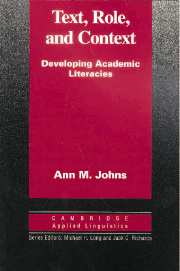Book contents
- Frontmatter
- Contents
- Series editors' preface
- Preface
- Acknowledgments
- 1 Literacy and pedagogy: Three views
- 2 Genre knowledge and socioliteracies: What readers and writers may share
- 3 Genre and social forces: “Homely” and academic texts
- 4 Discourse communities and communities of practice: Membership, conflict, and diversity
- 5 Special roles: Literacy practitioners as campus mediators and researchers
- 6 Students as researchers: Investigating texts, processes, and contexts
- 7 The socioliterate classroom: Basic tenets and goals
- 8 Putting tenets and goals into practice: Using portfolios in literacy classrooms
- 9 Conclusion
- References
- Index
1 - Literacy and pedagogy: Three views
Published online by Cambridge University Press: 05 October 2012
- Frontmatter
- Contents
- Series editors' preface
- Preface
- Acknowledgments
- 1 Literacy and pedagogy: Three views
- 2 Genre knowledge and socioliteracies: What readers and writers may share
- 3 Genre and social forces: “Homely” and academic texts
- 4 Discourse communities and communities of practice: Membership, conflict, and diversity
- 5 Special roles: Literacy practitioners as campus mediators and researchers
- 6 Students as researchers: Investigating texts, processes, and contexts
- 7 The socioliterate classroom: Basic tenets and goals
- 8 Putting tenets and goals into practice: Using portfolios in literacy classrooms
- 9 Conclusion
- References
- Index
Summary
It is within the students, of course, that the learning occurs, but it is within the teacher, who sits at the juncture of forces above, below and sideways that the learning situations are framed (Bazerman, 1994, p. 29).
If we write and teach [reading and] writing, we have a theory of [literacy] by definition (Zebroski, 1986, p. 57).
We all have theories: about politics, about art, about health, about relationships, about raising children – and about many other topics and events that are part of our everyday lives. Our theories, sometimes implicit and incomplete, help us to explain and to impose some order on the chaos of data that we experience. Most of us do not discuss our theories at an abstract level; in fact, we may not acknowledge that we have them. But we do. Sometimes we imply our theories through aphorisms. “Spare the rod and spoil the child” indicates a particular theory of childraising. “An apple a day keeps the doctor away” indicates a belief about the relationship between eating and good health.
There are fewer aphorisms about theories of literacy; instead, teachers tend to identify a commonly held theory and its pedagogical implications through a verbal shorthand: use of terms or phrases that other literacy practitioners are expected to understand. Teachers who subscribe to Traditional theories talk about “modes of writing” or “drill and practice.” Those with Learner-Based theories speak of “the Writing Process” or “Whole Language.”
Information
- Type
- Chapter
- Information
- Text, Role and ContextDeveloping Academic Literacies, pp. 1 - 19Publisher: Cambridge University PressPrint publication year: 1997
